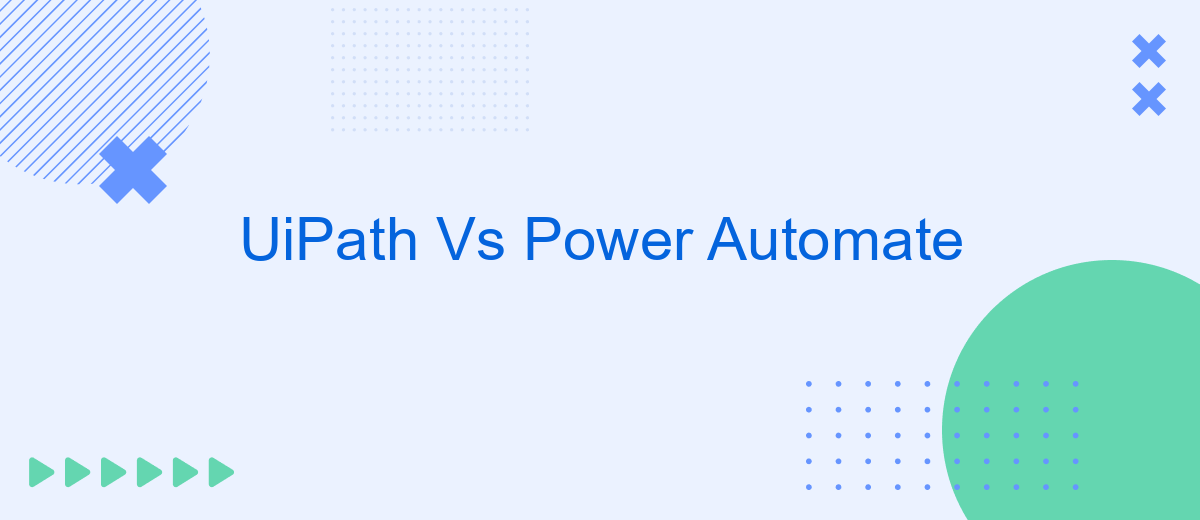In the realm of robotic process automation (RPA), UiPath and Power Automate stand out as leading contenders. Both platforms offer robust tools to streamline business processes, enhance productivity, and reduce manual labor. This article delves into a comparative analysis of UiPath and Power Automate, exploring their features, strengths, and potential drawbacks to help you make an informed decision.
Introduction
In today's rapidly evolving digital landscape, businesses are constantly seeking ways to automate repetitive tasks and streamline workflows. Two popular tools for achieving this are UiPath and Power Automate. Both platforms offer robust features to help organizations enhance efficiency and productivity, but they cater to different needs and user bases.
- UiPath: Known for its advanced capabilities in robotic process automation (RPA), UiPath is ideal for complex automation tasks and large-scale enterprise solutions.
- Power Automate: Integrated with the Microsoft ecosystem, Power Automate is user-friendly and perfect for automating workflows within Microsoft applications and services.
Choosing the right tool depends on various factors including the complexity of tasks, existing infrastructure, and specific business requirements. For instance, services like SaveMyLeads can further enhance your automation efforts by enabling seamless integration between different platforms and applications, ensuring a smoother workflow and better data management. Understanding the strengths and limitations of each tool will help you make an informed decision that aligns with your organizational goals.
Comparison of Features

When comparing UiPath and Power Automate, one of the key differences lies in their feature sets. UiPath offers a more comprehensive suite of tools for robotic process automation (RPA), including advanced capabilities for AI and machine learning. It provides a robust platform for automating complex workflows and integrating with a wide range of enterprise applications. Additionally, UiPath's extensive library of pre-built activities and its ability to handle unstructured data make it a powerful choice for businesses with intricate automation needs.
On the other hand, Power Automate, part of the Microsoft Power Platform, excels in its seamless integration with other Microsoft services like Office 365, Dynamics 365, and Azure. It is particularly user-friendly, making it accessible for non-developers to create automated workflows through a drag-and-drop interface. For businesses looking to streamline integrations, services like SaveMyLeads can be beneficial. SaveMyLeads simplifies the process of connecting various applications and automating data flow, enhancing the capabilities of platforms like Power Automate. Ultimately, the choice between UiPath and Power Automate depends on the specific needs and existing infrastructure of the organization.
Pricing and Licensing

When comparing UiPath and Power Automate, pricing and licensing are crucial factors to consider. Both platforms offer different pricing models to cater to various business needs and scales.
- UiPath: UiPath provides a flexible pricing model that includes a community edition for small businesses and individual developers. The enterprise edition offers more comprehensive features and is priced based on the number of robots and users.
- Power Automate: Power Automate offers a subscription-based pricing model, with plans starting from a per-user basis. Additionally, it provides a per-flow plan, which is suitable for organizations with high automation needs.
Both UiPath and Power Automate offer robust capabilities, but the choice between them may depend on your budget and specific requirements. For businesses looking to streamline integrations, services like SaveMyLeads can be beneficial. SaveMyLeads simplifies the process of connecting various applications, ensuring seamless data flow and enhanced productivity.
Integration Capabilities

When comparing UiPath and Power Automate, integration capabilities are a critical factor to consider. Both platforms offer robust options for connecting with various applications and services, enabling seamless workflows and data exchanges.
UiPath provides extensive integration support through its native activities and connectors. The platform offers pre-built integrations with popular enterprise applications like SAP, Salesforce, and Microsoft Office 365, allowing users to automate complex processes efficiently. Additionally, UiPath's REST API capabilities enable custom integrations with virtually any web service.
- Native integrations with enterprise applications
- Custom integrations via REST API
- Extensive library of pre-built connectors
On the other hand, Power Automate leverages its deep integration with the Microsoft ecosystem to provide seamless connectivity with services like SharePoint, Dynamics 365, and Azure. Moreover, third-party services such as SaveMyLeads can be utilized to streamline the integration process, making it easier to connect various tools and automate workflows. This flexibility ensures that users can create comprehensive automation solutions tailored to their specific needs.
Conclusion
In conclusion, both UiPath and Power Automate offer robust automation solutions, each with its own strengths and weaknesses. UiPath excels in providing a comprehensive platform for complex automation needs, making it ideal for large enterprises with diverse workflows. On the other hand, Power Automate is seamlessly integrated with Microsoft’s ecosystem, making it a convenient choice for businesses already utilizing Microsoft Office 365 and other related services.
When deciding between UiPath and Power Automate, it’s crucial to consider your specific business requirements, existing software infrastructure, and budget constraints. For those looking to streamline integration processes, services like SaveMyLeads can be invaluable. SaveMyLeads simplifies the setup of automated workflows by connecting various applications and services, enhancing the capabilities of both UiPath and Power Automate. Ultimately, the best choice will depend on your unique needs and the specific tasks you aim to automate.
FAQ
What are the primary differences between UiPath and Power Automate?
Can both UiPath and Power Automate be used together?
Which tool is more suitable for non-developers?
What are the typical use cases for UiPath and Power Automate?
How can I integrate third-party applications with UiPath and Power Automate?
Don't waste another minute manually transferring leads from Facebook to other systems. SaveMyLeads is a simple and effective tool that will allow you to automate this process so that you don't have to spend time on the routine. Try SaveMyLeads features, make sure that this tool will relieve your employees and after 5 minutes of settings your business will start working faster.
